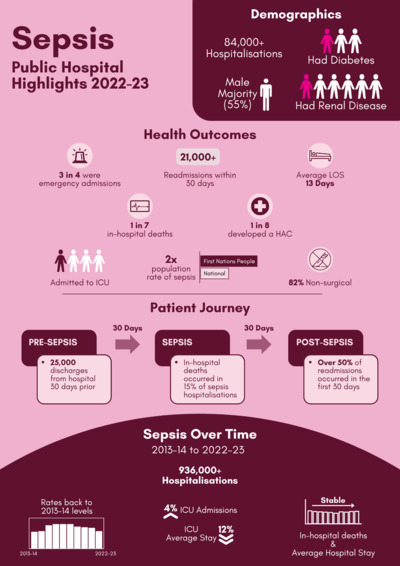Report: Sepsis more prevalent, deadly and costly than previously understood

Ahead of World Sepsis Day on 13 September, the Australian Commission on Safety and Quality in Health Care (the Commission) released its National Sepsis Program Extension Epidemiology Report. Analysing more than 900,000 sepsis-related hospitalisations in Australian public hospitals from 2013–14 to 2022–23, the report revealed that sepsis is more prevalent, deadly and costly than previously understood.
The report reveals there were more than 84,000 sepsis hospitalisations and more than 936,000 hospitalisations over the 10-year reporting period in 2022–23 alone — figures that are significantly greater than the previous estimate of 55,000 people affected each year. These findings have prompted renewed calls to improve clinical care, data quality and early detection across the healthcare system.
“Sepsis is a time-critical emergency,” said Conjoint Professor Carolyn Hullick, Chief Medical Officer of the Commission and emergency physician. “Our report shows that many Australians face not only a high risk of death, but also long recovery periods and repeat hospitalisations. We must do more to reduce the impact of sepsis on health services and improve patient outcomes and support health services in early recognition, treatment and discharge planning.”
Also offered by the report are insights into a range of health and social determinant risk factors. For example, the 2022–23 figures show:
- 1 in 3 people hospitalised for sepsis also had diabetes.
- 1 in 6 had renal (kidney) disease.
- Sepsis hospitalisation rates for Aboriginal and Torres Strait Islander people were double that of non-indigenous people.
- There is a higher risk of readmission linked to rural location and socioeconomic disadvantage.
“The link between complex chronic illness, socioeconomic disadvantage and higher rates of sepsis must shape how we deliver care,” Hullick said. “This data gives us a clearer picture of who is most at risk and how to intervene earlier.”
A promising sign of progress was also shown by the report, with a decline in the proportion of sepsis-related deaths occurring in EDs — a finding that suggests a growing impact from sepsis clinical pathways and education.
This report builds on the Commission’s work under the National Sepsis Program and supports the development of a National Sepsis Data Plan to improve consistency in coding and documentation.
You can read the report here, via the Commission’s website.
Resources
Concerned about sepsis: Healthdirect 1800 022 222
National Sepsis Program: Sepsis Awareness Resources
Sepsis Clinical Care Standard: Sepsis Clinical Care Standard
Could this tailored heart pump transform care for half of heart failure patients?
Half of the 64 million people living with heart failure have no access to heart pump treatments....
Breastfeeding challenges healthcare professionals should be prepared to address
A neonatal nurse and lactation consultant sets out what she sees as the most common breastfeeding...
Framework seeks to cut medicine errors at transitions of care
The first coordinated, hospital-based approach to medication management at transitions of care...





![[New Zealand] Transform from Security Awareness to a Security Culture: A Vital Shift for SMB Healthcare — Webinar](https://d1v1e13ebw3o15.cloudfront.net/data/89856/wfmedia_thumb/..jpg)
![[Australia] Transform from Security Awareness to a Security Culture: A Vital Shift for SMB Healthcare — Webinar](https://d1v1e13ebw3o15.cloudfront.net/data/89855/wfmedia_thumb/..jpg)




